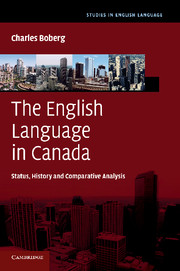Book contents
- Frontmatter
- Contents
- List of figures
- List of tables
- Acknowledgments
- Maps 1-3
- 1 English in the Canadian context
- 2 The establishment and growth of Canada's English-speaking population
- 3 The principal features of Canadian English in comparative perspective
- 4 Variation and change in the vocabulary of Canadian English
- 5 Variation and change in the phonetics of Canadian English
- 6 Summary and future directions
- References
- Index
6 - Summary and future directions
Published online by Cambridge University Press: 05 August 2011
- Frontmatter
- Contents
- List of figures
- List of tables
- Acknowledgments
- Maps 1-3
- 1 English in the Canadian context
- 2 The establishment and growth of Canada's English-speaking population
- 3 The principal features of Canadian English in comparative perspective
- 4 Variation and change in the vocabulary of Canadian English
- 5 Variation and change in the phonetics of Canadian English
- 6 Summary and future directions
- References
- Index
Summary
In the five preceding chapters of this book, three aspects of Canadian English have been emphasized: its current status as one of many languages spoken in Canada; its historical roots in settlement patterns; and its principal modern characteristics, viewed from both comparative and variationist perspectives. In this final chapter, the main outlines of these analyses will be briefly summarized and tentative projections will be made into the future, in terms of both research on Canadian English and the possible future development of the language itself. The analysis of Canadian English presented here is based on both the author's own research and the work of others, especially Avis, Chambers, Clarke, De Wolf, Gregg, Scargill, Warkentyne and Woods, as well as Labov, Ash and Boberg (2006) and data from Statistics Canada. Citations of this research are made throughout the foregoing chapters; in the interest of concision, they will not be repeated here.
The status, history and comparative analysis of English in Canada: a summary
In Chapter 1, English was seen to be the most widely spoken of many Canadian languages, being the mother tongue of about 18 million Canadians (57 percent of the national population). Of the other languages, the most important is French, Canada's other official language. Speakers of French are concentrated almost entirely in Quebec, where English is a minority language, and in neighboring regions of Ontario and New Brunswick. Canadians also speak a wide variety of non-official languages.
Information
- Type
- Chapter
- Information
- The English Language in CanadaStatus, History and Comparative Analysis, pp. 242 - 251Publisher: Cambridge University PressPrint publication year: 2010
